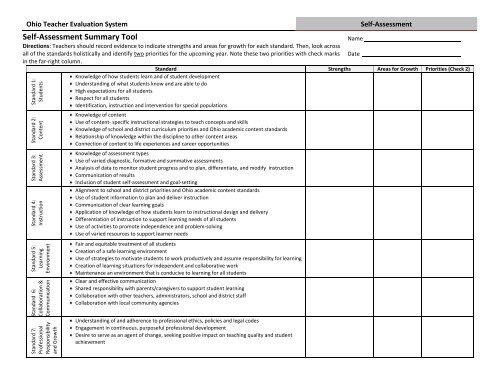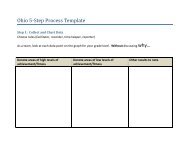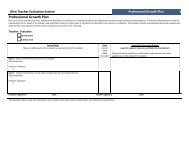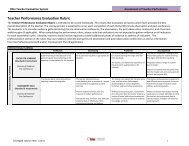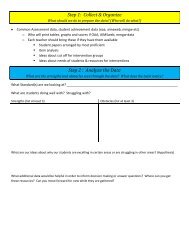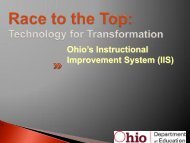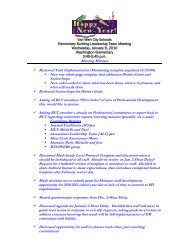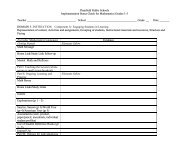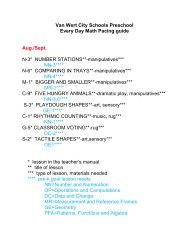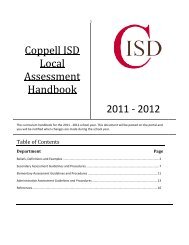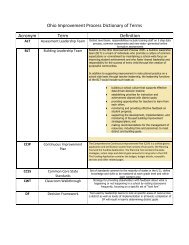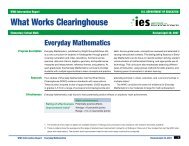Self-Assessment Summary Tool
Self-Assessment Summary Tool
Self-Assessment Summary Tool
You also want an ePaper? Increase the reach of your titles
YUMPU automatically turns print PDFs into web optimized ePapers that Google loves.
Standard 1:StudentsStandard 2:ContentStandard 3:<strong>Assessment</strong>Standard 4:InstructionStandard 5:LearningEnvironmentStandard 6:Collaboration &CommunicationStandard 7:ProfessionalResponsibilityand GrowthOhio Teacher Evaluation System<strong>Self</strong>-<strong>Assessment</strong> <strong>Summary</strong> <strong>Tool</strong>Directions: Teachers should record evidence to indicate strengths and areas for growth for each standard. Then, look acrossall of the standards holistically and identify two priorities for the upcoming year. Note these two priorities with check marksin the far-right column.<strong>Self</strong>-<strong>Assessment</strong>Standard Strengths Areas for Growth Priorities (Check 2)Knowledge of how students learn and of student developmentUnderstanding of what students know and are able to doHigh expectations for all studentsRespect for all studentsIdentification, instruction and intervention for special populationsKnowledge of contentUse of content- specific instructional strategies to teach concepts and skillsKnowledge of school and district curriculum priorities and Ohio academic content standardsRelationship of knowledge within the discipline to other content areasConnection of content to life experiences and career opportunitiesKnowledge of assessment typesUse of varied diagnostic, formative and summative assessmentsAnalysis of data to monitor student progress and to plan, differentiate, and modify instructionCommunication of resultsInclusion of student self-assessment and goal-settingAlignment to school and district priorities and Ohio academic content standardsUse of student information to plan and deliver instructionCommunication of clear learning goalsApplication of knowledge of how students learn to instructional design and deliveryDifferentiation of instruction to support learning needs of all studentsUse of activities to promote independence and problem-solvingUse of varied resources to support learner needsFair and equitable treatment of all studentsCreation of a safe learning environmentUse of strategies to motivate students to work productively and assume responsibility for learningCreation of learning situations for independent and collaborative workMaintenance an environment that is conducive to learning for all studentsClear and effective communicationShared responsibility with parents/caregivers to support student learningCollaboration with other teachers, administrators, school and district staffCollaboration with local community agenciesNameDateUnderstanding of and adherence to professional ethics, policies and legal codesEngagement in continuous, purposeful professional developmentDesire to serve as an agent of change, seeking positive impact on teaching quality and studentachievement
Ohio Teacher Evaluation SystemProfessional Goal-Setting <strong>Tool</strong>Part 1.1: Goal-Setting and Planning (to be completed by the teacher and evaluator at the beginning of the year)Data Sources that Indicate Need for Action (from various sources asrelevant)1.2.Standard (s) for Goal 1- circle all that apply:1- Students2- Content5- Learning Environment6- Collaboration and CommunicationGoal SettingNameDate3.3- <strong>Assessment</strong>7- Professional responsibility and GrowthEvaluator4- InstructionSMART (specific, measurable, attainable, relevant, and time-bound) Goal 1:Action Steps for Goal 1 Evidence Indicators Evidence/Artifacts to Collect TimelinePart 1.1: Goal-Setting and Planning (to be completed by the teacher and evaluator at the beginning of the year)Data Sources that Indicate Need for Action (from various sources as relevant)1.Standard (s) for Goal 1- circle all that apply:1- Students5- Learning Environment2.3.2- Content3- <strong>Assessment</strong>4- Instruction6- Collaboration and Communication7- Professional responsibility and GrowthSMART (specific, measurable, attainable, relevant, and time-bound) Goal 2:Action Steps for Goal 1 Evidence Indicators Evidence/Artifacts to Collect Timeline
Ohio Teacher Evaluation SystemProfessional Goal-Setting <strong>Tool</strong> (Part 2)Part 2: Mid-Year Progress Check (Goals 1 and 2)Date of Mid-Year Progress Check Conference:For teacher to complete:What has been your progress so far – action steps, evidence collection?How has this work impacted your teaching and student learning?What are your next steps?Goal-Setting ConferenceFor evaluator to complete:How successful has the teacher been to date at working towards the goals?What support would be helpful for this teacher to meet these goals?Part 3: End-of-Year Evaluation and Reflection (Goals 1 and 2)Date of End-of-Year Conference:For teacher to complete:What have you learned?What did you accomplish by working on these goals?Will you continue to work on these goals? How?For evaluator to complete:Evaluation of final outcomes: How well did teacher meet the goals?Impact on student learning: How did this work effect student learning?Teacher’s Signature: Date: Evaluator’s Signature: Date:
Ohio Teacher Evaluation SystemProfessional Goal-Setting RubricProfessional Goal-Setting RubricIn OTES, the work that teachers put into the goal-setting process informs the end-of-year summative rating of the teacher’s effectiveness.Evaluators may want to use a rubric like the following to rate the teacher’s performance. Because teachers have engaged in the goal-settingprocess with their evaluators, many potential problems will have likely been resolved early in the process. By the end of the process, it is assumedthat teachers will have set measurable, rigorous goals and taken clear steps to achieve them.NEEDSASSESSMENT/DATASOURCESACTIONSTEPS/EVIDENCEINDICATORSEVALUATION/REFLECTIONData are not used to identifyneeds.Goals are not tied to thestandards.Goals are not rigorous ormeasurable.Goals are not measurable.Planned steps do not allowfor mid-point progress check.Planned steps do not reflectgood practices.Teacher does not meettimeline for action steps.No artifacts are collected todemonstrate progress.Professional Goal-Setting Rating RubricIneffective Developing Proficient AccomplishedData are reviewed, but the Data are reviewed forMultiple data sources areneeds of specific student strengths and weaknesses reviewed in depth.groups are not examined in and for specific groups of Goals target specificdepth.students.standards.Goals are tied generally to Goals target specificstandards.standards.Goals are not rigorous.Goals are not met.Teacher cannot reflectthoughtfully on the processor convey learning.Goals are measurable.Action steps link to the goalbut may not allow for regularprogress checks.Planned steps reflect goodteaching practices.Teacher may not meettimeline for all action steps.Limited artifacts are collectedto demonstrate progress.Goals are easily obtained; nota stretch for teacher.Teacher demonstrates limitedreflection on learning.Goals are measurable.Action steps are clearly linkedto the goal and allow for midpointprogress check.Planned steps reflect goodteaching practices.Teacher meets timeline foraction steps.Artifacts collecteddemonstrate progresstowards goals.Goals are challenging.Goals are met or, if not,teacher communicateslearning and next steps.Goals are measurable.Action steps align with thegoal and allow for regularprogress checks.Planned steps are stronglybased in reliable and validresearch-based practices.Teacher meets set timelines,and may set additional stepsand timelines as a result ofprogress checks.Artifacts provide strong andthorough evidence.Goals are rigorous;achievement is demanding.Goals are met or, if not,teacher can communicatelearning from goals and nextsteps based on data.


